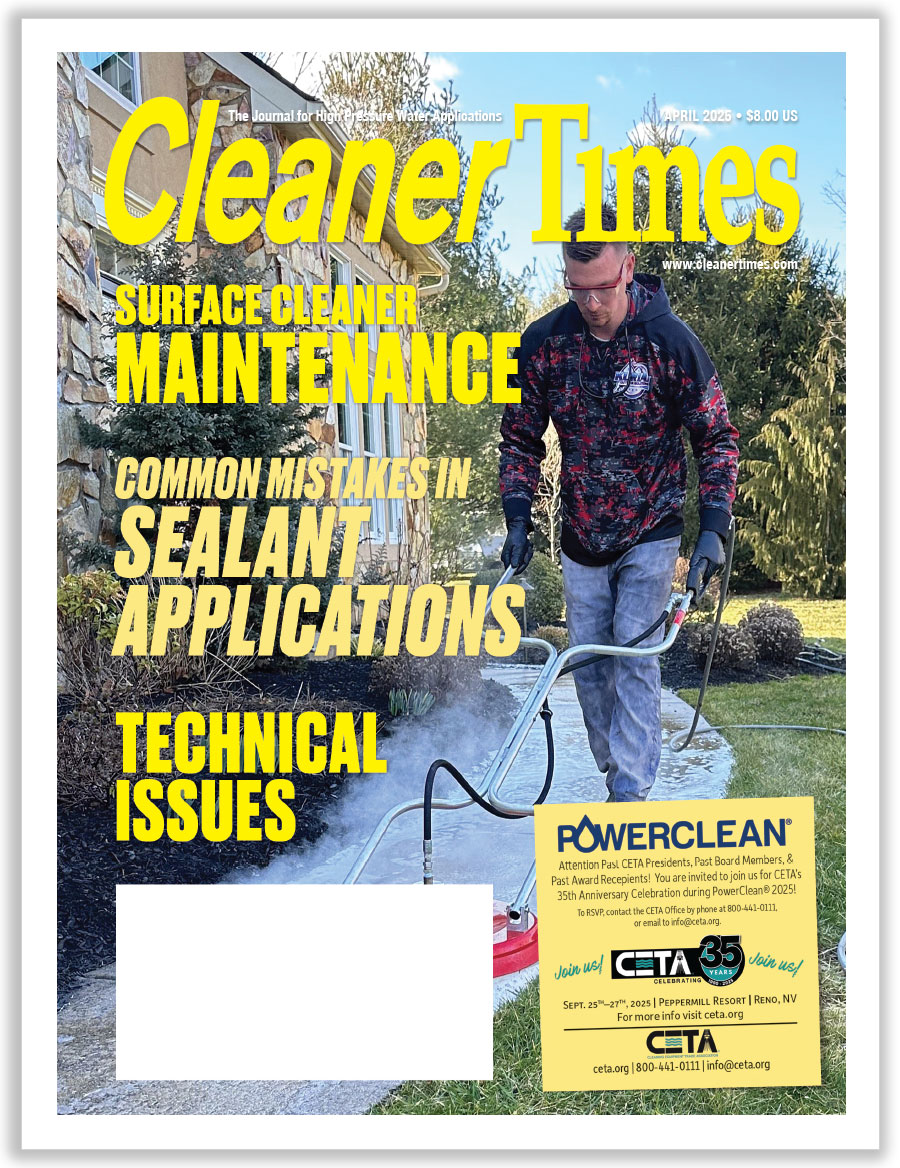
Setting Up A Service Repair Center
By Diane M. Calabrese / Published March 2017

Loaner machines? Credit checks? Hours of operation? Setting up a service center is not as simple as carving out a space and hiring an expert technician. A staggering number of decisions must be made.
Like every sphere of business, service centers have a history that moves generally toward more complexity. “Initially, most repair centers were begun by a person who went into the field and repaired cleaning equipment of all sorts,” says Bill Sommers, president of Pressure Systems Inc.—Mist Air in Phoenix, AZ.
The treks to the field soon made it obvious that for some types of repairs another setting was required, explains Sommers. The dedicated location, if successful, became a repair center. “Repair centers normally came up with a system that required a means of transportation with a lift, whether tailgate or fork, to handle the weighty objects,” says Sommers. “An assemblage of standard tools and some indigenous tools for the specialty jobs were required.”

What about configuration of a fledgling service center? “You didn’t plan or design a layout in the structure; you just put things where they belonged so that the work could be accomplished,” says Sommers.
Planning ahead often plays a role too. “There are many well-thought-out and well-planned service centers produced by companies that have been in pressure washer sales and service business,” says Sommers.
It’s really a matter of preference, or the owner’s approach to business—true, now, as much as it has always been. Whichever strategy—preplanned configuration, alterations along the way, or some of each—an owner takes to a service center, there are parameters that constrain choices.
Among the most significant parameters, according to Sommers, are climate, regulatory compliance, and documentation. “Climate largely determines how to facilitate the workload,” he explains.
Keeping the service area “clean and safe from injuries” is a must, too, says Sommers. OSHA [Occupational Safety and Health Administration] takes as keen an interest in service centers as it does in every other part of a business.
“Documentation is absolutely required—otherwise dollars disappear,” says Sommers. “When a company becomes busy enough, the computerization of parts through bar coding is essential to keep track and not leave the system open to human error.”
The service center at Sommer’s company [see sidebar] has become a very busy and vital part of the whole business with the addition of service to certain types of equipment in addition to pressure washers. (That points to another decision to be made: How restrictive should a service depart-
ment be in the equipment it repairs?)
A To Z
The pros and cons of setting up a service repair center are more often than not two sides of the same coin. Take foot traffic. A service repair center increases it.
More comings and goings at a distributorship can be a good thing if service center customers are receptive to looking at or hearing about new equipment. However, more activity can also be a distraction to sales efforts.
 Generating an A to Z list of issues to consider when deciding whether to set up a service repair center is easy and an undertaking that can force a business owner to consider all the plusses and minuses. To streamline here, though, we consider the big three into which all other issues arguably tie: regulations, management, and scope.
Generating an A to Z list of issues to consider when deciding whether to set up a service repair center is easy and an undertaking that can force a business owner to consider all the plusses and minuses. To streamline here, though, we consider the big three into which all other issues arguably tie: regulations, management, and scope.
Regulatory compliance is inextricably linked to doing business. Add a service repair center and the number of regulations affecting a business will grow. What provisions will be made to dispose of oil, metal, and other components? Which permits will be needed?
If a repair center cleans machines and generates waste water, it may need a special sewer for the water. It will have to comply with the requirements of the EPA’s National Pollutant Discharge Elimination System (NPDES) for its region. Should hazardous wastes be generated by dismantling or refurbishing equipment, more regulatory permits will be required. Service center technicians will be required to have hazmat training.
Any repairs done on equipment will have to bring equipment to standards required by current codes, not the codes that applied to the machine when it was built. Some customers may not want to pay for such upgrades.
The repair center itself must meet all requirements for worker safety—from the lifts used to proper ventilation to correct storage of potentially dangerous chemicals. Safeguards on tools and eye protection on workers are other issues that regulators will seize upon if they are found absent in a surprise inspection.
Management of a service repair center sets the tone for employees. A strong manager, one with both technical and organizational expertise, models what should be going on in a service repair center. A manager demonstrates how to interact with customers, including soothing the disgruntled, how to approach a repair, and how to track efforts in a way that provides appropriate billing.
In busy repair centers, a manager can focus on running the operation and the service technicians can focus on repairs. The separation of tasks can speed turnaround because technicians are not diverted from their work to talk with customers or track orders.
 Scope of a service repair center must be considered with great care. Servicing only certain brands of equipment reduces the inventory of parts needed. Opening a center to all brands can bring in new business, however, and generate the opportunity for sales of new equipment.
Scope of a service repair center must be considered with great care. Servicing only certain brands of equipment reduces the inventory of parts needed. Opening a center to all brands can bring in new business, however, and generate the opportunity for sales of new equipment.
Giving a loaner machine to a valued customer who purchased a machine from the same dealership generates goodwill. Any loaner policy must be completely spelled out, though. Regulators take a dim view of customers being treated differently, unless there’s a thoroughly and compellingly documented reason, such as customers who purchase from a dealership are eligible for loaner machines should their machine need more than one hour of service.
Similarly, if a service repair center does warranty work for a manufacturer, the owner must have a strong bond to the manufacturer. That bond will encompass adequate compensation for extensive warranty work.
Hours of operation of a repair center are also part of the scope. Open too late in the morning and customers may go elsewhere. During the busiest part of the year for contractors, a repair center might consider extended hours, at least for drop offs in the morning.
A service repair of sufficient size can add amenities, such as pick up of machines at job sites or on-site repair of machines. Both can be revenue enhancers if the owner of the repair shop has a sufficiently large sustained workload and territory.
For all the dimensions of regulations, management, and scope that must be assessed—and there are many more still—there are two aspects of setting up a service repair center that might sway a dealer to take the leap. Contractors appreciate being able to get their equipment repaired, and service repair centers ultimately are green enterprises.
A contractor wants to realize full life from a machine. Any service repair center that can help the contractor meet that goal will be valued, as will the dealership to which the center is connected. When the contractor does want to buy a new piece of equipment or ancillaries, the trusted dealership will more than likely get the first opportunity to make the sale.
Every piece of equipment that has a full lifespan conserves resources that would be required to build a replacement. It also is one less addition to a landfill—in part or in its entirety. Repairing equipment is truly a green endeavor.
Service Repair Center at Pressure Systems—Mist Air
Contributed by Elizabeth Houde, Chief Operating Officer
We are a third-generation family-owned business serving Arizona and the Southwest for more than 50 years. Our primary business has focused on pressure washing equipment and the service/repair of this equipment.
The most important elements in a service repair center are the quality, knowledge, and skill of the repair servicemen. Our shop has employed the same people for more than 20 years, and this expertise is essential to retain satisfied customers.
Our center was initially planned, but over the years we were flexible and adjusted to meet the needs of the business. Our biggest change was the decision to open a “parts center,” so that our customers could also purchase parts and chemicals as needed.
In order to establish a successful service repair center, you need two things: excellent repair men/women who understand this market segment and customers who require this service. A market research study is an important step in the decision-making process and the investment of funds in a repair and service center.
As an example of the importance of assessing climate when facilitating workload, in Arizona and the Southwest, we regularly have massive dust storms called haboobs. These storms bring a soil-dwelling fungus to the cities. This causes Valley Fever, a respiratory disease that is especially dangerous for children and senior citizens. Customers need pressure washers and the correct chem- icals to clean this dust from homes, businesses, schools, cars at auto dealerships, construction sites, and so on.





